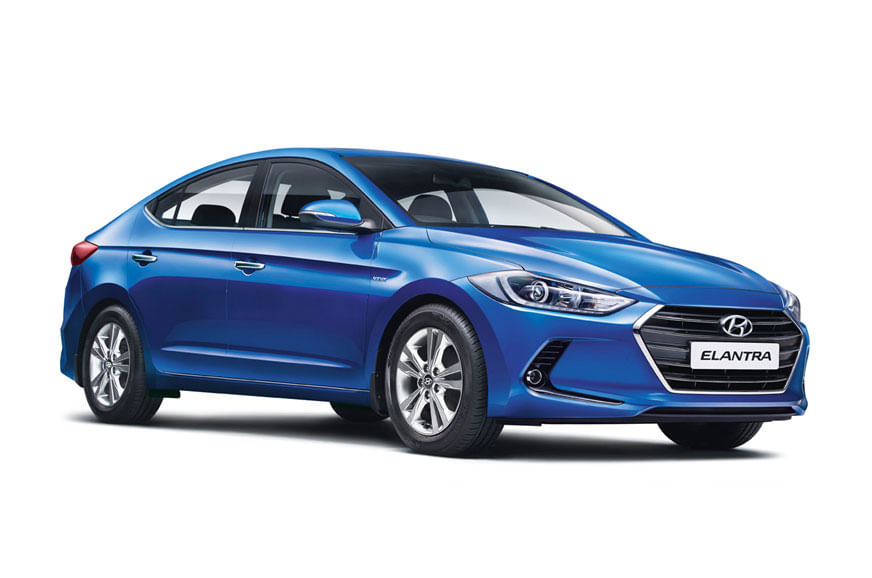2016 Hyundai Elantra review, test drive
The new Elantra looks even better than the last one. But what's it like behind the wheel?
Updated on Aug 10, 2016 01:05:11 PM
41,751 Views
Follow us on



The stunning 2006 Civic sedan was the first car in its class to carry a low-slung look. Designers used a low grille, a shallow bonnet, a steeply raked windscreen, a rising shoulder line and a relatively low roof to successfully deliver the impression of a car that sat really low to ground. Yes, a couple of European luxury carmakers had used a similar look before, and so had a few from the US, but Honda was the first to bring the low-slung trend to the mass market. And initially, the reaction was just fantastic; people just stared at the car when it hit our roads.
Even more attractive was the car that followed a few years later; Hyundai’s fifth-generation Elantra. A car that wholeheartedly embraced the ‘low-slung’ look as well as Hyundai’s fluidic design philosophy, the Elantra was both perfectly proportioned and beautifully detailed. Many, in fact, felt the Elantra was Hyundai’s best-looking car ever. And many still do.
But while the low-slung look made these cars look extremely attractive and initial demand was good, many customers in the later years thought these cars were a bit too impractical for everyday use (even though in reality they weren’t). Honda was quick to react and put a high-nosed version of the Civic into the US market; it immediately went on to become the bestselling car in the US. Fast forward a few years later and Hyundai, today, has done something similar with the new Elantra, a car that’s headed here next month.
Three Dimensions
Walking up to the white car for the first time draws mixed reactions. I sort of miss the flowing lines of the earlier car. I miss the stance, and I miss the view from the rear with the long tail-lights running around the back. And those big rear-wheel arches, I kind of liked them too. But I like this new car as well, a lot, and walking around the car allows me to take it in all at once. One thing’s for sure, this new Elantra does look like it has evolved from the earlier one. And this is clear when you look at the roofline and the boot, which, in profile, look similar.
The nose of the new Elantra, however, is all new. More ‘stand up’ now, the higher cowl and the more conventional bonnet give the front an all-new look. And the tall, Audi-like hexagonal grille helps differentiate it to a large extent too. Other elements that work particularly well include the strong bonnet ‘V’ that blends perfectly with the grille, the headlights that fit in with the grille perfectly and I also like how the rounded air dam is supported by the tall vertical ‘brackets’. The latter, interestingly, aren’t there for decoration only, but have a practical use as well; they house air inlets that channel the airflow through the bumper and around the front wheels, forming what is known as an ‘air curtain’. This reduces turbulence around the front wheels and improves stability and fuel economy. The new nose also makes the car look more compact in profile, despite the fact that the new car is actually longer. Around the back, the nicely executed rear looks quite attractive as well, especially with the LED inserts in the tail-lights on.
Tech Fest
Under the skin, the Elantra sees a massive step up in technology. The monocoque is now made up of a higher grade of steel. A massive 53 percent of the steel now used on the car is high-strength steel (HSS) versus 21 percent on the earlier car, and the chassis, as a result, is a full 30 percent stiffer; a massive amount. Also used for added stiffness, structural adhesives from the aerospace industry that bond the various bits together like a weld. Good stuff.
The suspension of the Elantra has been improved. The front struts can now use more supple springs due to the greater stiffness in the chassis and Hyundai’s engineers have increased the caster of the front suspension to improve steering feel at higher speeds. Hyundai has also included ‘Drive Mode’ system on the new Elantra that changes the amount of steering effort needed and alters throttle responses and engine mapping if you select something like ‘Sport’. The dampers aren’t adjustable on this system yet though.
Also massively improved on this car are electronic driver aids and safety systems. A six-airbag system comes as standard in most markets, there’s blind spot detection that’s quite useful in traffic and the new Elantra also gets radar-based cruise control. Cars in the US also get lane keep assist and automatic emergency braking; what exactly we’ll get on the India-spec car, however, isn’t clear yet.
An Elegant Drive
Setting off from rest in the new Elantra is an impressively smooth and effortless affair; and truth be told, that comes as quite a surprise. There’s an air of sophistication to the driving experience not felt on many Japanese cars in this class and the manner in which it smoothly picks up pace and seamlessly shifts gears is quite surprising too. This slick performance is aided, no doubt, by the fact that the cabin is now more silent, and the fact that the engine has a nice, meaty bottom end clearly helps too.
This impression that this car has come a long way between generations is further reinforced as I step up the pace. The improved insulation is now all the more apparent, as we cruise along the elevated highway at around 120kph, and even though we are hitting more than a few joints in the road surface, the suspension is also filtering out the road nicely, with hardly any tapping or drumming sounds coming through.
Even stability at speed is quite solid. There is no nervousness to speak of. The Elantra takes long sweeping corners in its stride and even the brakes deliver a confidence-inspiring bite when you need to slow down in a hurry. It even feels neat and tidy in tighter and faster corners. Sure, there weren’t too many to be found on the island city of Singapore and we had to really seek them out in various places around the fringes, but then someone directed us to a group of abandoned warehouses, around which we could really drive the car without disturbing anyone. And again, the Elantra proved more than capable. First off, Hyundai’s odd steering correcting feature, seen on the earlier car in India, has either been vastly improved or is absent on this new car altogether. Yes, the steering is quite lifeless and dull and there’s very little actual feel, but it is pretty direct and accurate. And what allows you to enjoy the car is the fact that the Elantra tucks into corners quite neatly and even drives through them with quite a bit of composure. So, flicking the car from one 90-degree bend to another isn’t too much of a chore.
Even the ride is pretty good. As you can imagine, the roads around Singapore aren’t exactly littered with bad patches and potholes, but wherever we seemed to encounter a rough section or even a less than perfectly paved side road, the Elantra sponged up the surface imperfections quite easily. It may not be as good over the bigger potholes and there’s likely to be a bit of up and down movement over bad patches; but that’s only to be expected.
What was quite lacking on the Elantra I drove in Singapore was a bit of real performance. Yes, the engine has 128hp on paper and that should, in theory, be sufficient, but the Hyundai motor isn’t impressive past the mid-range as it struggles and strains. And the six-speed automatic is slow to respond when you want to execute a downshift. The good news, however, is that Hyundai has a much peppier engine on the cards for India – a 149hp 2.0-litre unit – and this is likely to be followed by a nicer twin-clutch gearbox as well.
Internal Audit
If Hyundai has excelled in any one area in recent years, it has to be the cabin. Space and comfort are always afforded priority, the cabins are generally built to a very high standard and hasn’t Hyundai all but pioneered the concept of the lavishly equipped car?
Here too, seat comfort is very good. The electric front seats are wide, large and very supportive and because the seats are equipped with a memory function, you can get comfortable in the driver’s seat in a jiffy, every time. And the side bolstering on the front seats is also quite good. Even space in the rear is more than sufficient. There’s a fair amount of legroom in the rear even if there is a tall person sitting up front and the seat back is nicely reclined. The cushioning on the leather seats is excellent and even your feet are placed at a nice angle. Under-thigh support could have been a bit better. However, you are sat a bit low compared to some of the best back seats in the class such as the Jetta, but the seat is so good overall, this is hardly likely to matter. Headroom at the rear, however, could be a bit of an issue if you are really tall, and that’s due to the sloping roof.
The design of the cabin is also quite a departure from that of the earlier car. Whereas the earlier Elantra had some fairly outlandish details, like the centre console that narrowed dramatically and then widened again, this new car is almost Germanic, both in its attention to detail and its line and form. The instrument panel, centre console and steering wheel are as neat and straight laced as you can get, the metallic highlights work beautifully and the fit, finish and build of the various buttons is so good, it’s nearly as good as those found on a Skoda or VW. Even functionality is great. The only fly in the ointment, as it were, is that the proportions of some of the bits on the inside seem well, a bit off. The instrument panel and vents somehow look too ‘tall’ for the rest of the cabin and the manner in which the vents taper look abrupt as well.
The cabin, however, has a solid and robust build to it, you get ventilated seats as on the earlier car, and Electronic Stability Control (or ESP) is likely to come as standard on the new Elantra when it comes to India next month. The Elantra also gets a unique feature; Hyundai’s Smart Trunk system. Go close to the boot with just the key in your pocket and stand next to it for a bit and it will flash its tail-lights twice at you and open up; no wild flaying of hands or legs required. Pretty neat.
First Impressions
Hyundai’s new Elantra is a big step forward over the earlier car. The new design is sure to attract many potential buyers, the cabin is well built and comfortable and the Hyundai, with its new engine for India, is likely to be fairly nice to drive as well. Yes, it is up against some heavy hitters in the form of the Octavia and Jetta and there are still areas where these cars nose ahead easily, but look at the Elantra as a package and Hyundai’s new executive is likely to be much more competitive. Can’t wait to drive it against its competition: watch this space. It really does have a shot.
Upcoming
Copyright (c) Autocar India. All rights reserved.







Comments
Member Login
Personal Details
No comments yet. Be the first to comment.